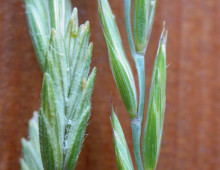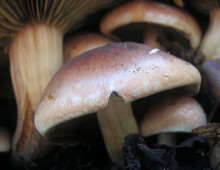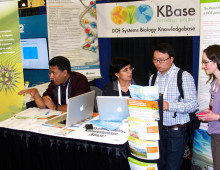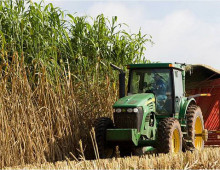Intermediate Wheatgrass (IWG) is a highly productive perennial grass species that is being developed as a new biomass and grain crop. As a perennial crop, IWG can provide essential ecosystem services to current agricultural practices such as stabilizing soil with its deep root structure, reducing nutrient runoff, and limiting weed growth. IWG produces biomass quantities…
Fungal Evolution of Truffle-Like Bodies
The reproductive success of fungi is heavily influenced by climate. For those fungi that produce emergent mushroom-like fruit bodies, periods of drought or heat can severely curtail the spread of these fungi within an ecosystem due to rapid drying of the developing hymenium thus limiting spore production and dispersal. Some fungi have evolved the adaptation…
Diurnal Cycles in Chlamydomonas
Chlamydomonas reinhardtii is a DOE JGI flagship species and the premier reference organism for unicellular green algae. It is an important reference system for many aspects of plant cell and molecular biology, especially as they relate to energy and carbon metabolism including lipid and starch storage and utilization in photosynthetic systems. Chlamydomonas offers an unprecedented…
JGI at PAG XXIV
JGI will be sharing a booth (#202) at The Plant and Animal Genome XXIV Conference (PAG) in San Diego from Sunday, January 10 through Tuesday, January 12, 2016 with our colleagues from KBase: The Department of Energy Systems Biology Knowledgebase. Also, on Tuesday, January 12, 2016 from 4:00-6:10 pm in the San Diego Room, join us…
Microbial Mutualism with Orchids
Mycorrhizal fungi usually transfer nitrogen and phosphorus to plants, and receive carbohydrates. However, the orchid mycorrhizal symbiosis is unique because the mycorrhizal fungi transfer carbon to the plant, at least during early developmental stages. All orchids are dependent on fungi for seed germination and form mycorrhizae with basidiomycete fungi. These mycorrhizal fungal species are primarily…
Systems Analysis of Sorghum-Soil Microbiome Interactions
To compete in the energy market, biofuel feedstocks need to be high yielding and carbon neutral or negative. To avoid competition with existing food production systems, these crops will need to be grown on marginal lands with few inputs. Researchers plan to take a systems approach to dissect complex genotype by environment interactions in the…
Joint Genome Institute/UC Merced Genomics Distinguished Graduate Internship Program
The JGI/UCM Genomics Graduate Distinguished Graduate Internship Program is a program for graduate students at the University of California, Merced (UCM), to spend the summer in labs at the DOE Joint Genome Institute (JGI). It is jointly sponsored by the two institutions. The objectives of this program are to: Introduce students to emerging genomics technologies…
Single Cell Genomics for Station ALOHA samples
Research over the past half-century has built a coherent, conceptual framework for biogeochemical dynamics in natural microbial ecosystems, but quantitative biological and systems biology approaches are only just now beginning to be applied to natural microbial systems. In this project, the researchers intend to apply genome-enabled quantitative systems biology approaches to describe the model open…
Metagenomics of Deep Ocean Crust Communities
Hydrologically sealed boreholes that penetrate through the sediment and into the basaltic crust currently provide the only direct means to sample microbial life within the fluids percolating through the Earth’s vast sediment-buried subseafloor basement. Only a handful of boreholes have been designed specifically for microbiological sampling of the basaltic subseafloor. Researchers plan to compare microbial…
Influence of Phycosphere on Algae for Biofuel
Microalgae are among the most productive microbial biofuel options. Many algae accumulate neutral lipids or triacylglycerol as storage products, and can be grown on alternative water sources and marginal lands. Additionally, these organisms naturally sequester carbon dioxide and help control greenhouse gas accumulation in the atmosphere. Through a community systems biology approach, researchers hope to elucidate…





